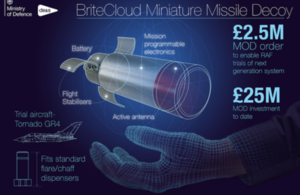MOD orders UK-designed mini missile decoy for RAF
The UK Ministry of Defence (MOD) has placed a £2.5 million order for UK-designed and built miniature decoys which will help to protect combat jets from missiles.

Packed with missile-confusing advanced electronics, BriteCloud can be fired from an aircraft’s flare dispenser without the need for modification to the aircraft.
The cutting-edge BriteCloud system, designed and manufactured in Bedfordshire and Scotland by Leonardo-Finmeccanica, will undergo flight trials on RAF Tornado aircraft later this year.
BriteCloud, which is similar in size and appearance to a beverage can, can be fired from an aircraft’s flare dispenser without the need for modification to the aircraft. Once deployed, it uses powerful radar emissions to disrupt systems within radar-guided air-to-air and surface-to-air missiles.
A pilot can launch the compact unit, which is packed with advanced electronics, to confuse an attacking missile, drawing it away to a point where it no longer poses a threat.
Defence Secretary Michael Fallon said:
The cutting-edge technology behind BriteCloud demonstrates the MOD’s commitment to harnessing and growing the incredible creativity in our Defence supply chain.
Supported by our £178 billion investment in equipment, these new decoy systems show that we are continually pushing the boundaries of innovation, making the most of Great British skills and brains to keep our Armed Forces safe from our adversaries.
Chief Executive Officer at the MOD’s Defence Equipment and Support organisation, Tony Douglas said:
The development of BriteCloud has only recently been made possible after many years of advances in technology, and shows how UK Defence, in partnership with industry, is leading the charge when it comes to research and development.
Flight trials planned for later this year will test the system’s effectiveness against a wide range of current and potential threats, helping to ensure that UK pilots have the tools they need to successfully complete their missions wherever they are in the world.
The MOD has been working with Leonardo-Finmeccanica to develop the BriteCloud system since 2012. The project is sustaining around 25 design jobs at the company’s Edinburgh and Luton sites.
Other companies in the supply chain include Chemring, based in Whiteley, Hampshire, and QinetiQ, based in Farnborough, Hampshire, and Boscombe Down, Wiltshire.
To date, the MOD has invested around £25 million in the BriteCloud system through a project commissioned by Defence Science and Technology Laboratory (Dstl) and managed by Defence Equipment and Support (DE&S).
This new £2.5 million batch order will allow the RAF to explore how BriteCloud could best be deployed operationally. If successful, the system could be available for Tornado aircraft operations by mid-2017.
Wing Commander Matthew Tandy, Protection of Air Operations Desk Officer for the Royal Air Force said:
BriteCloud is much easier to install on a variety of aircraft than previous bulkier decoy systems, because it can be used from existing countermeasure dispensers such as flare launchers.
Although the devices are highly advanced, they are straightforward to use. They can be easily re-programmed during operations to defeat new threats as they are encountered, giving the RAF an important advantage in engagements.